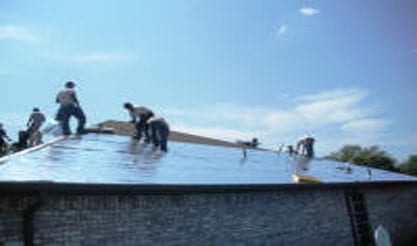How A Roof Radiation Barrier Can Save You Money
A roof radiant barrier can not only save you money on your heating and cooling costs, but it also helps to preserve the life of your roof. If you’re considering purchasing a new home or remodeling an existing one and want to know more about the benefits of a roof radiant barrier, then this article is for you!
When you think of insulation, what comes to mind? You might imagine white fluffy balls stacked up in one area or a layer of bubble wrap surrounding your furnace. These are just examples of insulation and as for the latter – it doesn’t actually serve any purpose! In this article, we’ll explore the different kinds of insulation, what they’re made of, their pros and cons, and the best kind to have on your roof.
What is a Roof Radiant Barrier?
 A roof radiant barrier (RRB) is a type of insulation used to reduce heat loss from a roof. RRBs are made from materials such as plastic, glass, or foam that are attached to the roof with either screws or nails. They work by reflecting back some of the sun’s heat, keeping the roof cooler in the summer and warmer in the winter.
A roof radiant barrier (RRB) is a type of insulation used to reduce heat loss from a roof. RRBs are made from materials such as plastic, glass, or foam that are attached to the roof with either screws or nails. They work by reflecting back some of the sun’s heat, keeping the roof cooler in the summer and warmer in the winter.
When considering whether or not to install a roof radiant barrier, it can be helpful to understand what the device is and how it works. A roof radiant barrier is a type of insulation that uses heat to reduce energy costs in your home. The barrier is made up of several sheets of metal that are tightly bound together.
When the sun shines on the metal, it creates heat that can then be transferred into the attic or roof space. This heat can then be used to warm your house in cold winter months or cool your house in hot summer months.
How a Roof Radiation Barrier Works
Roof radiant barriers work by reflecting heat back into the attic, instead of letting it escape out the roof. The barrier reflects sunlight and heat back into the attic, which means that there is less heat and sunlight entering your home through the roof. This can save you money on your heating and cooling bills.
When selecting a roofing material, it is important to consider several factors including climate and the cost of installation. Some of the more popular types of roofing materials are asphalt shingles, wood shakes, metal roofs, and slate. Your choice of roofing material will depend on what kind of look you prefer for your home. A metal roof may be a good choice if you live in an area with harsh winters.
The metal will allow for better insulation and better protection from the elements during the winter months. Metal roofs also tend to be less expensive than other kinds of roofs and are very durable. Slate is another great option that allows for both beauty and durability as well as low maintenance costs over time.
If you are looking to install a roof radiation barrier, there are a few things to keep in mind. First, make sure that the roof is properly sealed. Second, make sure that the barrier is mounted properly so that it will reflect heat back into the attic. Finally, make sure that the barrier is sized for your home.
How to Install a Roof Radiation Barrier
Radiant barriers can help reduce the amount of heat that enters your home, saving you money on cooling costs. This guide will teach you how to install a roof radiation barrier.
Installation of roofing materials, including radiant barriers, calls for experts. Summit Roof Services can explain the benefits, and provide installation to help you start saving money on your heating and cooling costs.
At Summit Roof Service Inc., we install radiant barriers to reduce radiant heat by 95%. In an unprotected attic, temperatures can soar 20 to 30 degrees above outside air temperatures, costing you substantial money in energy costs.
Pros and Cons of A Roof Radiation Barrier
A roof radiation barrier can help you save money on your energy bill. Here are the pros and cons of installing a roof radiation barrier:
Pros of installing a roof radiation barrier:
-You can reduce your energy bill by up to 50%.
-The installation is relatively simple and can be completed in a few hours.
-There is no need for any repairs once the barrier has been installed.
-The barrier is effective in blocking both short- and long-wave radiation, which means it can protect you from both heat and light damage.
Cons of installing a roof radiation barrier:
-The installation may require some modification to your roofing system.
-The barrier may not be effective in preventing all types of radiation exposure.
-Some people may experience some minor discomfort or difficulty when using fans or air conditioning during hot weather.
Call Summit Roof Services for Radiant Barrier Installation!
A roof radiant barrier can help you save money on your energy bills. The barrier works by using a reflective coating to bounce the sun’s rays away from your home, preventing them from reaching the inside of your home and heating up your rooms. This system is typically installed in areas where direct sunlight enters, such as a front or rear porch, garage, or side of the house. If you are interested in learning more about this technology and whether it could be a good investment for your home, please contact us today!
We at Summit Roof understand certain doubts that surround the roofing industry. Today, a lot of roofing contractors “promise” top-notch service, at great rates, but follow up such a promise with defective service and inflated pricing. As a result, customers are inconvenienced and unhappy.
Summit Roof Service Inc. makes the same promise, but we follow through on it. How can you trust us? We’re a family-owned and operated business that has carried out excellent roofing services since 1993. We have a committed and proven staff. Plus, we have a track record of success as expressed by our excellent online reviews. Call us today in Allen (972) 715-1655 or Grapevine (972) 484-7774!
Visit our social media for more details about roof radiation barrier.
